|
Noh Costumes
Noh costumes refer to the entire range of garments worn by the actors of Noh, one of the traditional performing arts of Japan. Noh plays are performed with minimum movement on a simple stage backed by a wooden wall (kagami-ita) on which is painted a single, giant old pine tree. Sumptuous and ornate,Noh costumes, together with Noh masks, are vital in their representation of status, age, character, and even the emotion portrayed by the roles.
Noh drama
The origin of Noh is closely rela(ed to religious ritual. As an early form of music and dance, Noh performances were dedicated to temples and shrines, and therefore performed in the precincts or in the hall of worship. Later, Noh began to be performed on a stage temporarily constructed outdoors, under the name of Kanjin. After the artists Kan'ami and Ze'ami, of Noh became a drama staged to entertain people. Formal Noh stages were construeted in the Nishihonganji temple and Itsukushima Shrine.
In the Meiji era the Noh theater in its present form was constructed, the stage and seats being arranged as seen today. At presen Takigi Noh (Nob performed in the open in nights, and illuminated by lighted torches) is performed throughout Japan. However,Takigi Noh was originally a ritual of offering firewood at the Koufukuji temple in Nara in February. On that occasion, Noh was performed during the day to accompany the ceremony, '' Takigi-no-en" (Feast of Firewood).
Types of Noh Costumes
Kituke (Inner Garment)
A costume worn beneath the uwagi (Outer garment). lt is an inner garment, not underwear.
| Surihaku |
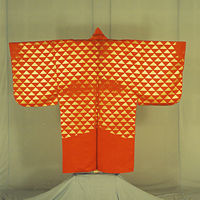 An inner garment for female roles. Patterns are Created by pressing gold or silver leaf on paste which is applied in the desired configuration on the fabric. The so-called "urokohaku" (repeated pattern of triangular scales), in particular, symbolizes deep attachment and uncontrolled passion in women, and is used for female roles that appear in Noh drama as demons or serpents. An inner garment for female roles. Patterns are Created by pressing gold or silver leaf on paste which is applied in the desired configuration on the fabric. The so-called "urokohaku" (repeated pattern of triangular scales), in particular, symbolizes deep attachment and uncontrolled passion in women, and is used for female roles that appear in Noh drama as demons or serpents. |
| Nuihaku |
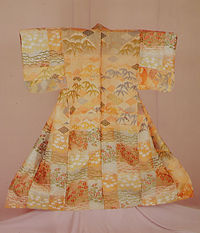 This costume is primarily worn as an inner garment for female roles. It is also worn around the waist, allowing the upper part to hang loosely down. It employs colorful embroidery and gold and silver leaf to create elaborate patterns. Together with karaori, it represents the Japanese sense of beauty in Noh costumes. Nuihaku can be divided into two groups:"iro-iri" (with red) and "iro-nashi" (without red). The most decorative is the so-called ''douhakuji" type in which rich embroidery is applied all over a gold-leaf ground. Nuihaku is also worn for male roles, such as courtiers and infants. This costume is primarily worn as an inner garment for female roles. It is also worn around the waist, allowing the upper part to hang loosely down. It employs colorful embroidery and gold and silver leaf to create elaborate patterns. Together with karaori, it represents the Japanese sense of beauty in Noh costumes. Nuihaku can be divided into two groups:"iro-iri" (with red) and "iro-nashi" (without red). The most decorative is the so-called ''douhakuji" type in which rich embroidery is applied all over a gold-leaf ground. Nuihaku is also worn for male roles, such as courtiers and infants. |
Hakama (Trousers)
| O-kuchi |
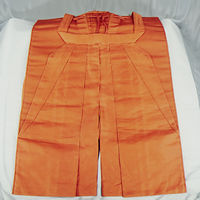 Formally called"o-kuchi-bakama," these short-length trousers have tucks in the front Which are made of a lustrous, supple sdk fabric; the solid, flat, square back is made of ribbed fabric. These trousers are worn for both male and female roles of high ranks. Formally called"o-kuchi-bakama," these short-length trousers have tucks in the front Which are made of a lustrous, supple sdk fabric; the solid, flat, square back is made of ribbed fabric. These trousers are worn for both male and female roles of high ranks. |
Uwagi (Outer Garment)
Uwagi is worn over the kituke (inner garment). It hangs from the shoulders or the head. From the manner in which the outer garment is worn, the status, age and personality of the role are conveyed to the audience.
| Karaori |
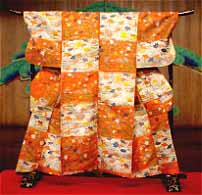 An elaborate, ornate garment typical of Noh costumes. It is primarily worn as an outer garment in female roles. The aya (twill) silk fabric is so woven that the colorful wefts float on the surface, and the fabric looks as if it is intricately embroidered. The use of gold and silver thread brings a luxurious dimension to this costume. Karaori that uses the color red is referred to as "iro-iri, " and is worn by the actor playing the role of a young woman while Karaori without red is referred to as "iro-nashi," and is worn for the roles of middle-aged, elderly women or women of divine nature. The garment may also be worn as an inner garment by actors in the roles of young noblemen. An elaborate, ornate garment typical of Noh costumes. It is primarily worn as an outer garment in female roles. The aya (twill) silk fabric is so woven that the colorful wefts float on the surface, and the fabric looks as if it is intricately embroidered. The use of gold and silver thread brings a luxurious dimension to this costume. Karaori that uses the color red is referred to as "iro-iri, " and is worn by the actor playing the role of a young woman while Karaori without red is referred to as "iro-nashi," and is worn for the roles of middle-aged, elderly women or women of divine nature. The garment may also be worn as an inner garment by actors in the roles of young noblemen. |
| Choken |
 A typical Noh costume primarily worn by dancing female roles. Sleeves are sewn to the shoulder, but the sides of the body are left open. This elegant, lightweight costume uses thin ro or sha silk fabric combined with gold and silver colored yarn. This costume can be worn instead of happi by actors playing young noblemen of the Heike clan, A typical Noh costume primarily worn by dancing female roles. Sleeves are sewn to the shoulder, but the sides of the body are left open. This elegant, lightweight costume uses thin ro or sha silk fabric combined with gold and silver colored yarn. This costume can be worn instead of happi by actors playing young noblemen of the Heike clan, |
| Mizugoromo |
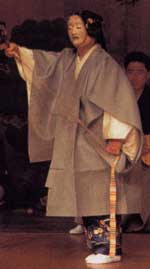 A solid or striped garment of lighweight woven silk fabric such as suzushi, sha and shike. It is worn by almost all roles of both sexes and all ages. However, it is most frequently worn by actors playing monks, elderly men and laborers. A solid or striped garment of lighweight woven silk fabric such as suzushi, sha and shike. It is worn by almost all roles of both sexes and all ages. However, it is most frequently worn by actors playing monks, elderly men and laborers. |
Typical Noh Costumes
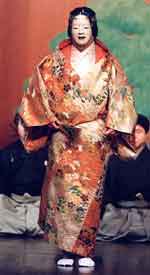 @ Kinagasi
|
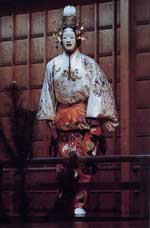 kosimaki kosimaki
|
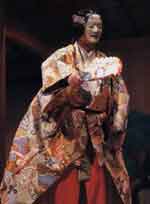 @ Tuboori
|
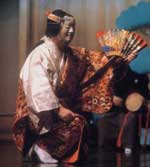 @ Nugikake
|
Design and Color of Noh Costumes
 Noh costumes display a wide variety of designs that can be roughly grouped into female and male motifs. While the motifs for female roles strongly reflect Japanese taste, those for male roles show a strong Chinese influence. Noh costumes display a wide variety of designs that can be roughly grouped into female and male motifs. While the motifs for female roles strongly reflect Japanese taste, those for male roles show a strong Chinese influence.
Costumes for female roles are adorned with a wide variety of floral and plant designs, reflecting the beauty of the four seasons of Japan. For example, plum blossoms and narcissus are used to convey early spring. This is followed by the dandelion, weeping cherry and Japanese kerria of mid-spring, then the wisteria, iris and wild pink of summer. Colored leaves, fall grasses and insects express autumn. Snow-capped bamboo, willow and pine trees represent winter. Particularly noteworthy is the abundance of autumn grasses. All these plants are incorporated in Noh costumes with a great freedom of design thereby conveying the Japanese sense of beauty while being faithful to the actual colors and shapes of the plants.
Noh costumes are also characterized by the contrast of colors. In the world of Japanese beauty the colors of many flowers and grasses are combined with stunning effect. White dominates, while navy and purple, when used with gold brocade, provide a sharp contrast. For example, white surihaku is combined with black kosimaki and red karaori to heighten the effect of contrast. Even in the chic, muted combinations of neutrals as seen in atuita, one notices, on close observation that the same principle of color contrast is applied. These costumes and their colors act in perfect harmony by complementing one another, adding depth to the stage, and providing the audience with a powerful aesthetic impression.

|
|
|
 An inner garment for female roles. Patterns are Created by pressing gold or silver leaf on paste which is applied in the desired configuration on the fabric. The so-called "urokohaku" (repeated pattern of triangular scales), in particular, symbolizes deep attachment and uncontrolled passion in women, and is used for female roles that appear in Noh drama as demons or serpents.
An inner garment for female roles. Patterns are Created by pressing gold or silver leaf on paste which is applied in the desired configuration on the fabric. The so-called "urokohaku" (repeated pattern of triangular scales), in particular, symbolizes deep attachment and uncontrolled passion in women, and is used for female roles that appear in Noh drama as demons or serpents. This costume is primarily worn as an inner garment for female roles. It is also worn around the waist, allowing the upper part to hang loosely down. It employs colorful embroidery and gold and silver leaf to create elaborate patterns. Together with karaori, it represents the Japanese sense of beauty in Noh costumes. Nuihaku can be divided into two groups:"iro-iri" (with red) and "iro-nashi" (without red). The most decorative is the so-called ''douhakuji" type in which rich embroidery is applied all over a gold-leaf ground. Nuihaku is also worn for male roles, such as courtiers and infants.
This costume is primarily worn as an inner garment for female roles. It is also worn around the waist, allowing the upper part to hang loosely down. It employs colorful embroidery and gold and silver leaf to create elaborate patterns. Together with karaori, it represents the Japanese sense of beauty in Noh costumes. Nuihaku can be divided into two groups:"iro-iri" (with red) and "iro-nashi" (without red). The most decorative is the so-called ''douhakuji" type in which rich embroidery is applied all over a gold-leaf ground. Nuihaku is also worn for male roles, such as courtiers and infants. Formally called"o-kuchi-bakama," these short-length trousers have tucks in the front Which are made of a lustrous, supple sdk fabric; the solid, flat, square back is made of ribbed fabric. These trousers are worn for both male and female roles of high ranks.
Formally called"o-kuchi-bakama," these short-length trousers have tucks in the front Which are made of a lustrous, supple sdk fabric; the solid, flat, square back is made of ribbed fabric. These trousers are worn for both male and female roles of high ranks. An elaborate, ornate garment typical of Noh costumes. It is primarily worn as an outer garment in female roles. The aya (twill) silk fabric is so woven that the colorful wefts float on the surface, and the fabric looks as if it is intricately embroidered. The use of gold and silver thread brings a luxurious dimension to this costume. Karaori that uses the color red is referred to as "iro-iri, " and is worn by the actor playing the role of a young woman while Karaori without red is referred to as "iro-nashi," and is worn for the roles of middle-aged, elderly women or women of divine nature. The garment may also be worn as an inner garment by actors in the roles of young noblemen.
An elaborate, ornate garment typical of Noh costumes. It is primarily worn as an outer garment in female roles. The aya (twill) silk fabric is so woven that the colorful wefts float on the surface, and the fabric looks as if it is intricately embroidered. The use of gold and silver thread brings a luxurious dimension to this costume. Karaori that uses the color red is referred to as "iro-iri, " and is worn by the actor playing the role of a young woman while Karaori without red is referred to as "iro-nashi," and is worn for the roles of middle-aged, elderly women or women of divine nature. The garment may also be worn as an inner garment by actors in the roles of young noblemen. A typical Noh costume primarily worn by dancing female roles. Sleeves are sewn to the shoulder, but the sides of the body are left open. This elegant, lightweight costume uses thin ro or sha silk fabric combined with gold and silver colored yarn. This costume can be worn instead of happi by actors playing young noblemen of the Heike clan,
A typical Noh costume primarily worn by dancing female roles. Sleeves are sewn to the shoulder, but the sides of the body are left open. This elegant, lightweight costume uses thin ro or sha silk fabric combined with gold and silver colored yarn. This costume can be worn instead of happi by actors playing young noblemen of the Heike clan, A solid or striped garment of lighweight woven silk fabric such as suzushi, sha and shike. It is worn by almost all roles of both sexes and all ages. However, it is most frequently worn by actors playing monks, elderly men and laborers.
A solid or striped garment of lighweight woven silk fabric such as suzushi, sha and shike. It is worn by almost all roles of both sexes and all ages. However, it is most frequently worn by actors playing monks, elderly men and laborers. @Kinagasi
@Kinagasi kosimaki
kosimaki @Tuboori
@Tuboori @Nugikake
@Nugikake Noh costumes display a wide variety of designs that can be roughly grouped into female and male motifs. While the motifs for female roles strongly reflect Japanese taste, those for male roles show a strong Chinese influence.
Noh costumes display a wide variety of designs that can be roughly grouped into female and male motifs. While the motifs for female roles strongly reflect Japanese taste, those for male roles show a strong Chinese influence.